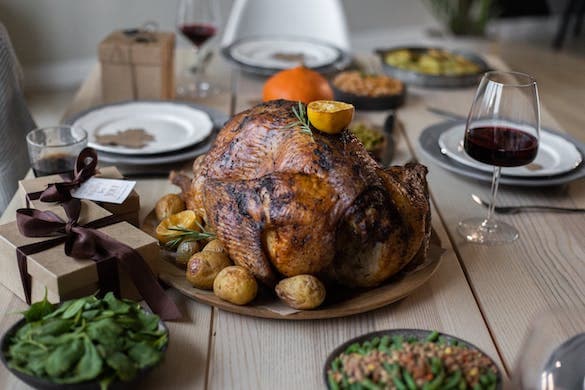Like Fantasy Football, Only for Thanksgiving: A Fantasy Feast Lineup
Here are the six things I’d bring to dinner, if I could. They aren’t impossible to get, overly priced, or super obscure, but tried and true wines of tradition to celebrate this food- and family-focused holiday.

Thanksgiving this year will be spent abroad with only my nuclear family, away from my wine collection and good wine shops that have access to my favorite bottles. I thought I’d take a page from fantasy football, and come up with my fantasy feast lineup instead. Below are the six things I’d bring to dinner, if I could. They aren’t impossible to get, overly priced, or super obscure, but tried and true wines of tradition to celebrate this food- and family-focused holiday.
Welcome Wine, or the Drink-While-I-Cook Bottle: Chartogne-Taillet, Champagne Cuvée Sainte Anne Brut, NV, $62.99
Champagne is my favorite style of wine and my required starting point. If I was hosting a huge gathering, I might pick some very good, but much less expensive, bubbles to share, like AT Roca’s Penedes Classic Reserva Metode Tradicional for the killer price of $24.99, but this is my fantasy, so we start here.
Chartogne-Taillet is run by Alexandre Chartogne, a grower and prodigy of the great Anselm Selosse, and a philosophizing, experimental farmer and winemaker in his own right. His Cuvée Sainte Anne is one of Champagne’s greatest non-vintage wines. It blends three to six vintages of Chardonnay, Pinot Noir, and Pinot Meunier from more than 10 different vineyards spread across his holdings at Merfy, one of the region’s northernmost villages. Most of the fermentation and aging of the vin clair, or still wine, is done in various used oak barrels.
Alexandre’s holistic farming and low-intervention methods in the cellar allow for a pure expression of terroir, heightened complexity, seamless structure, and cohesion rarely seen in wines at this price. It’s got high acid, but isn’t too sharp, there are some fresh green apples but the focus is on the kernel, brioche and tertiary notes. If I had to pick only one wine for the night, this would be it, as it would stand up to every dish on the table.
Appetizers: Willi Schaefer, Graacher Himmelreich Riesling Kabinett, 2020, $39.99
This is another bottle that could carry one through a whole meal, as Riesling is magic — and especially with just a touch of residual sugar like Kabinett has. It pairs with everything (including the impossible-to-pair green beans), but for those afraid of the R word, my acid and mineral bomb, sans RS, would be Bernhard Ott, Der Ott Gruner Veltliner, 2021 $44.99.
If Riesling is magic, Christoph Schaefer is a sorcerer. The wines from the top-rated village of Graach in Germany’s Mosel Valley are delicious — no matter the vintage, no matter the bottling. The problem is finding them; at a paltry 4.2 hectares, with four low-yielding vintages in a row and a newfound obsession from the cognoscenti, they have become fleeting.
The hunt, though, is worth it (and I know a wine shop in New York with a big stash). They’re just silly-delicious. You cannot be unhappy drinking these perfect Mosel Rieslings. As crystalline as they are, as ethereally complex and limpidly clear, they have a quality of calm; they don’t fuss at you with how amazing they are. It’s as if Whitney Houston sang a capella: perfect, soul wrenching, and impossible to duplicate.
Creamy White Foods: Domaine des Comtes Lafon, Meursault 1er Cru Porusots, 2012 (1.5L) $1,199.00
Bigger really is better, and my no. 1 piece of advice for Thanksgiving feasts is always bring a magnum or larger to share. But, okay, this wine doesn’t really follow my criteria, as it’s obscure, hard to find, and expensive, but a girl can dream can’t she? I want a perfect bottle of white Burgundy, and I want it now.
What I would actually bring is Chateau Yvonne, Saumur Blanc, 2021 ($56.99). This is one of the few classic French wines, from a cult-y producer, that has not really gone up in price at the rate of those around it. Saumur Champigny is known for Cabernet Franc, Chenin Blanc, and its pinnacle producer, Clos Rougeard. Chateau Yvonne, though having a long history — with vines originally planted by medieval monks — didn’t start to gain its share of the spotlight until 2007, when Matthieu Vallée took over and changed everything, for the better.
I love both his Chenin Blanc and Cabernet Franc wines (which would all do well at this fantasy table) up and down the price ladder. Matthieu certified the vineyards biodynamic in 2012, and took a more terroir-focused approach to winemaking with native yeast fermentation, no additions other than SO2, minimal racking, and bottling unfined and unfiltered.
Le Gory, his top white, is absolutely astounding, but only one to two barrels are produced a year, and at double the price of this village wine. Making me more than happy to radiate in the glow of the slightly less structured (read, earlier drinking) tippler. It makes for some wonderfully relaxed and refined drinking. There’s no shortage of teeth-tingling acidity, mouth-coating lanolin, hay, beeswax, and lots of chalky minerality, too. Lemon gelato, honey, smoke, rocks, and pineapple. Just yum.
Other Colors on Your Plate: Chateau Thivin, Cote de Brouilly, 2022, $36.99
Many people make the mistake of bringing a big, complex, show-stopping red to a Thanksgiving feast. Unfortunately, they often overpower the food, fill you up, and get you tipsy even quicker. In reality, what the table really needs is three things:
Simplicity. To pair with as many dishes as possible, and not overshadow any of them.
Low tannin. There isn’t usually a lot of red meat at a Turkey dinner, so no need to get a rip-roaring Cabernet Sauvignon or Nebbiolo (both are usually too complex, anyway).
High acid. To cut through all the rich food: mac ‘n cheese, gravy, sweet potatoes. Think of it like cranberry sauce as a chaser, without the wobbly ridges. (I prefer fresh cranberry sauce.)
Beaujolais — of which the Cru, Côte de Brouilly, belongs — nails all three attributes. The other mistake people make is hating Beaujolais. To be fair, the bad reputation was and in some circumstances still is deserved. For decades, George Duboeuf and his copycats watered down the reputation of an entire region with their insipid, uninspired, horribly farmed, mass-produced swill, which they were able to label Beaujolais. They also marketed Beaujolais Nouveau, originally made as an end-of-harvest celebratory “early wine” to be drunk in the fields, not bottled and shipped across the globe ready just in time to ruin your family meal.
Have no fear, Thivin is nothing like those Bojo’s of old. It’s elegant, silky, balanced, and totally delicious. It’s time to give the region another shot.
The Show Stopper: Chateau Grand-Puy-Lacoste, Pauillac, 2005, $169.99
I know I just said one doesn’t need a robust Cabernet Sauvignon on the turkey table, but sometimes we just can’t help ourselves. Luckily, there is a great option for fulfilling all the requirements above: Aged Bordeaux.
Acidity in Cabernet Sauvignon from the Left Bank of Bordeaux is often higher than those from warmer climates, like Napa Valley. Alcohol levels are also lower, avoiding the full/tipsy problem. Tannins, which can be through the roof in a young French wine, have started to mellow out with 10-plus years of aging, feeling less aggressive, and not overworking your inundated palate.
The only “problem” is how incredibly complex they are. Cassis and plum are wrapped in a cigar box, tobacco, leather, cedar, black pepper, spices, wet earth, and stones. This will probably be more delicious than anything on your menu, but have it last and let it linger.
You also don’t need to spend $170. While the wine above is sure to knock the socks off anyone at the table, but you can get a great approximation for a lot less. Good wine shops should have access to quality Bordeaux, with some age that doesn’t break the bank. Chateau Sociando-Mallet, Haut-Medoc, 2012 ($48.99) and Chateau Massereau, Bordeaux Superieur Cuvee K, 2013 ($33.99) are two options that spring to mind.
Dessert: Henriques & Henriques, Madeira 20 Year Old Verdelho, NV, $139.99
To properly finish up an American holiday, your drink of choice should be Madeira, a favorite of the Founding Fathers and colonists. Madeira is misunderstood and massively underappreciated, as I argued in this column last year(https://www.nysun.com/article/ditch-the-beer-and-drink-like-our-founding-fathers). The bottom line is that it’s one of the most food-friendly wines out there, with very high acidity and a range of sweetness levels, from barely there to unctuous.
Verdelho is the perfect middle road, being one step sweeter than Sercial, the driest of them all, but often more balanced and not quite so searing, with a dry-ish finish. The wine is made by purposely maderizing, or heating it up, which gives it an unbelievable spectrum of flavor: mango, orange zest, pink grapefruit, apricot, pineapple, fig, red pepper, baking spices, caramel, hazelnut, walnut oil, honey comb, almond, tobacco, vanilla, sea spray…. The list never ends.
Maderizing also makes it inscrutable. Open this wine tonight, drink half a glass (I dare you to stop there), and next year it will be just as good (maybe better). The price tag starts to really feel worth it. Don’t want to dive so deep into an unknown pool? Check out the Broadbent, 5 Year Old Madeira Reserve, NV ($25.99), a whopping good deal that’s also off-dry, less effusive, but with a seductive finish you will want to revisit again and again.
Whatever your plans for this holiday, I hope you enjoy yourself and stay safe, sane, and healthy.

